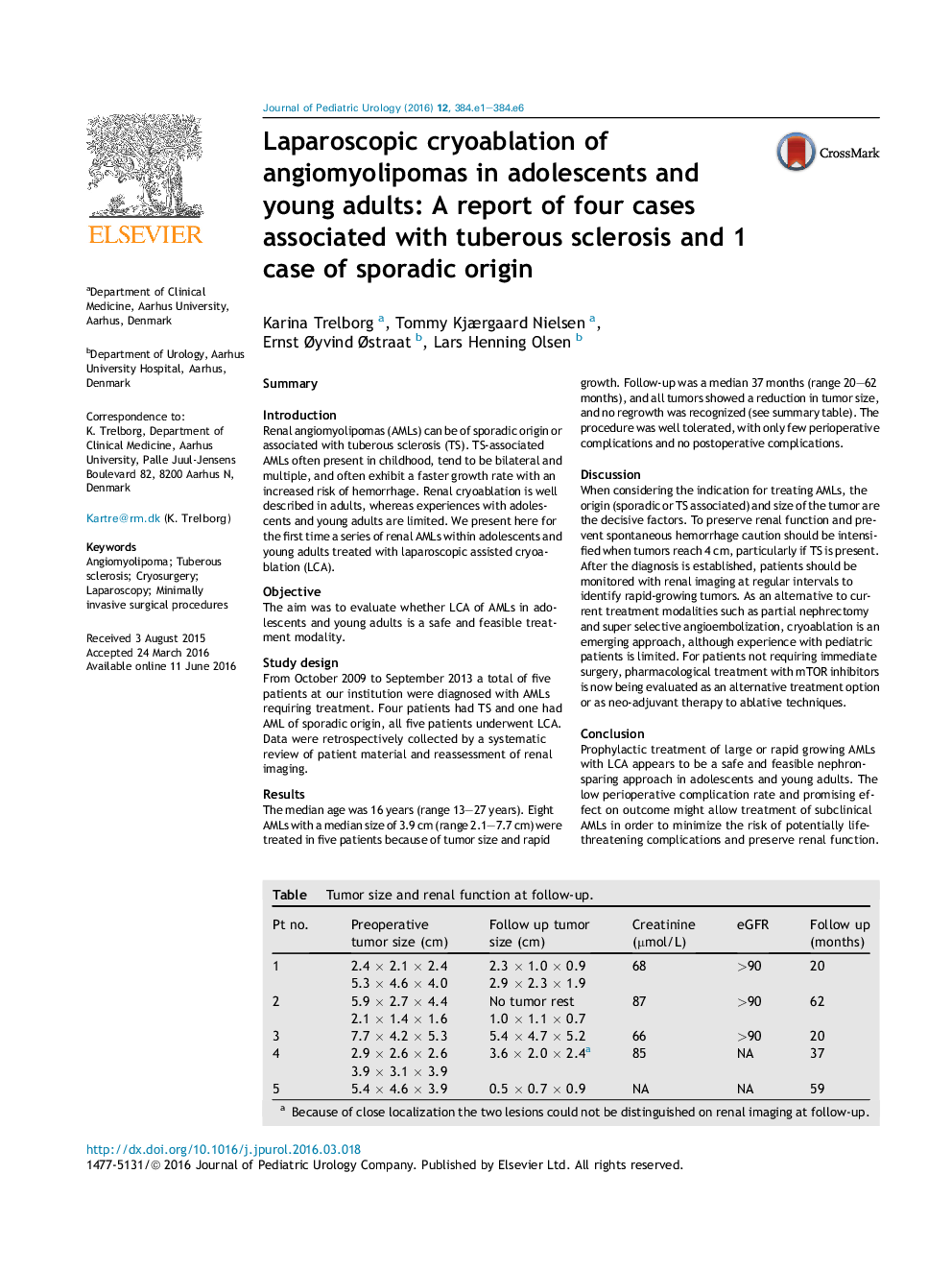| کد مقاله | کد نشریه | سال انتشار | مقاله انگلیسی | نسخه تمام متن |
|---|---|---|---|---|
| 5718709 | 1411256 | 2016 | 6 صفحه PDF | دانلود رایگان |

SummaryIntroductionRenal angiomyolipomas (AMLs) can be of sporadic origin or associated with tuberous sclerosis (TS). TS-associated AMLs often present in childhood, tend to be bilateral and multiple, and often exhibit a faster growth rate with an increased risk of hemorrhage. Renal cryoablation is well described in adults, whereas experiences with adolescents and young adults are limited. We present here for the first time a series of renal AMLs within adolescents and young adults treated with laparoscopic assisted cryoablation (LCA).ObjectiveThe aim was to evaluate whether LCA of AMLs in adolescents and young adults is a safe and feasible treatment modality.Study designFrom October 2009 to September 2013 a total of five patients at our institution were diagnosed with AMLs requiring treatment. Four patients had TS and one had AML of sporadic origin, all five patients underwent LCA. Data were retrospectively collected by a systematic review of patient material and reassessment of renal imaging.ResultsThe median age was 16 years (range 13-27 years). Eight AMLs with a median size of 3.9 cm (range 2.1-7.7 cm) were treated in five patients because of tumor size and rapid growth. Follow-up was a median 37 months (range 20-62 months), and all tumors showed a reduction in tumor size, and no regrowth was recognized (see summary table). The procedure was well tolerated, with only few perioperative complications and no postoperative complications.DiscussionWhen considering the indication for treating AMLs, the origin (sporadic or TS associated) and size of the tumor are the decisive factors. To preserve renal function and prevent spontaneous hemorrhage caution should be intensified when tumors reach 4 cm, particularly if TS is present. After the diagnosis is established, patients should be monitored with renal imaging at regular intervals to identify rapid-growing tumors. As an alternative to current treatment modalities such as partial nephrectomy and super selective angioembolization, cryoablation is an emerging approach, although experience with pediatric patients is limited. For patients not requiring immediate surgery, pharmacological treatment with mTOR inhibitors is now being evaluated as an alternative treatment option or as neo-adjuvant therapy to ablative techniques.ConclusionProphylactic treatment of large or rapid growing AMLs with LCA appears to be a safe and feasible nephron-sparing approach in adolescents and young adults. The low perioperative complication rate and promising effect on outcome might allow treatment of subclinical AMLs in order to minimize the risk of potentially life-threatening complications and preserve renal function.Table. Tumor size and renal function at follow-up.Pt no.Preoperative tumor size (cm)Follow up tumor size (cm)Creatinine (μmol/L)eGFRFollow up (months)12.4 Ã 2.1 Ã 2.45.3 Ã 4.6 Ã 4.02.3 Ã 1.0 Ã 0.92.9 Ã 2.3 Ã 1.968>902025.9 Ã 2.7 Ã 4.42.1 Ã 1.4 Ã 1.6No tumor rest1.0 Ã 1.1 Ã 0.787>906237.7 Ã 4.2 Ã 5.35.4 Ã 4.7 Ã 5.266>902042.9 Ã 2.6 Ã 2.63.9 Ã 3.1 Ã 3.93.6 Ã 2.0 Ã 2.4a85NA3755.4 Ã 4.6 Ã 3.90.5 Ã 0.7 Ã 0.9NANA59aBecause of close localization the two lesions could not be distinguished on renal imaging at follow-up.
Journal: Journal of Pediatric Urology - Volume 12, Issue 6, December 2016, Pages 384.e1-384.e6